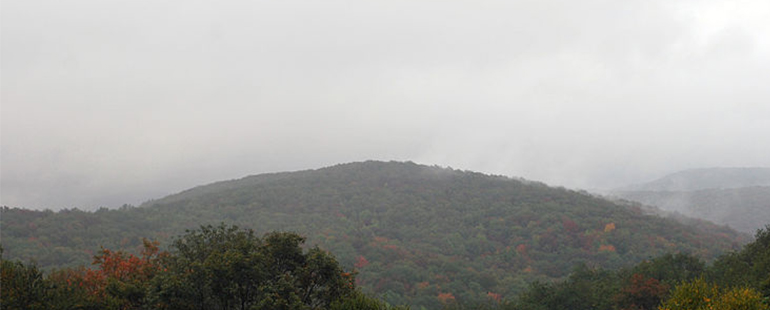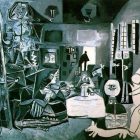Appalachia from the Outside

Readers of Emma Copley Eisenberg’s The Third Rainbow Girl: The Long Life of a Double Murder in Appalachia might be surprised to learn that the titular third girl, Liz Johndrow, appears in less than a quarter of the book. Her presence, however, looms large over the murders of Nancy Santomero and Vicky Durian, Johndrow’s friends and sometimes hitchhiking companions, as well as in the psyche of Eisenberg. As she writes in “True Things,” the introduction to her true-crime memoir, “When I think of all this as a story, I think of her.”
Johndrow, whose life briefly but indelibly intersected with the people of Pocahontas County, the West Virginia community where Santomero and Durian were murdered on their way to the Rainbow Gathering in 1980, becomes a sort of doppelganger for Eisenberg as she portrays herself in the memoir portions of her book. Johndrow, after all, is the outsider pulled into the community who becomes part of a communal story despite her lack of history with and ties to the area. This is a position that Eisenberg feels clear empathy for. Like Johndrow, she is drawn into the story of the murders, and she finds herself fascinated by the effect they had on the people and culture of Pocahontas County. Eisenberg, a New York native, is compelled to tell the story of the crimes, even as she struggles with her biases and prejudices regarding the county and with her knowledge of the damage done by mainstream writers who have misunderstood and misrepresented Appalachian culture. Far from being self-indulgent, then, the memoir portions of The Third Rainbow Girl become crucial to Eisenberg’s purpose, laying bare her flaws and misconceptions and creating a compelling and empathetic exploration of Appalachia written by a non-native.
As Eisenberg herself acknowledges, the stakes for such an exploration are far from low. Appalachia has long served as a national other for the United States, the repository of our prejudices and ugly anxieties regarding poverty, politics, and society. As a disaffected college student taking a summer job in Pocahontas County, Eisenberg quickly realizes that her contradictory images of West Virginia, of “OxyContin and Jesus. Mother Jones and Don Blankenship. Knobby elbows and the fattest city in America,” are “gross misinformation,” but she lacks any sort of cultural awareness that would help her untangle and make sense of the stereotypes.
Most readers still lack this awareness in a country where the popular representations of Appalachians are capitalist wish-fulfillment like J.D. Vance’s Hillbilly Elegy and the thousands of articles dissecting “Trump Country” published in the wake of the 2016 election. In taking on the Rainbow Murders, Eisenberg also takes a responsibility for presenting a clearer picture of the region—a balance that is particularly difficult to achieve when discussing the murder of two young women.
Durian and Santomero were shot to death, their bodies abandoned near an isolated road. Although several suspects have been proposed, their deaths remain unsolved to this day. The question of who is responsible continues to divide Pocahontas County, where local gossip and a criminal trial tipped the scales against a group of local men who were later acquitted. It’s the kind of story that could very easily devolve into caricature, a fate Eisenberg avoids through self-examination.
Eisenberg begins this project with an open admission of her alienation from Appalachia. Such an admission is not only gratifying for Appalachian natives but also serves as an invitation to mainstream readers to confront and revise their views on Appalachia alongside Eisenberg. Fighting a deep dissatisfaction with her privileged, liberal arts existence—in her own words “the desire to drop. . .out of my life”—Eisenberg accepts a summer position at a non-profit, academic summer camp for teenage girls located in Pocahontas County. The job, which leads to full-time employment at the camp after she graduates from Haverford College in southeastern Pennsylvania, is a classic starting place for simplified myths of impoverished, abused young women and the cultured outsiders who rescue them from their irredeemable backwater. Eisenberg soon learns, however, that the history of Appalachia, and her interactions with it, are much more complicated. Researching the region, she learns how West Virginia was first stripped of its natural resources, and then its national dignity, by exploitive corporations and a public hungry for stories of rural decay and poverty to justify the exploitation. She discovers the state’s myriad contradictions, from the dismal state of reproductive healthcare to its thriving trans community.
In the midst of this discovery, Eisenberg’s own extended breakdown and fight with depression lay bare her own faults and insecurities. Girls leave the camp and she feels powerless to stop them. She falls into relationships with local men that bring questioning and emotional turmoil, but also expose her to the complexities of the region’s gender roles and expectations. These experiences lead to a gradual transformation that allows her to see Pocahontas County with a newly empathetic gaze. Encountering a former camper, she is able to admit that “I had made a mistake thinking I knew what it looked like for myself to disappear or what it looked like when someone else did.” Through the lens of her personal experiences, Eisenberg is able to understand and accept the multiplicity and contradictions that define not only life in Appalachia, but also the world at large; the camper may be trapped and spiraling out of control, or perhaps she is simply enjoying herself during an afternoon of beer and boys. Thinking of these possibilities, Eisenberg realizes that “both things were possible and were likely happening at the same time.”
This double vision becomes especially valuable when writing about a case entrenched in local conjecture and prejudice that defies easy explanations or clear answers. When she began, Eisenberg was convinced that it was a “general crime of misogyny” woven into the region that had led to Durian and Santomero’s deaths. It was only when she dug deeper into the history of Pocahontas County that she developed a more empathetic understanding of the area’s relationship to the crimes. Eisenberg uses the memoir portions of The Third Rainbow Girl to develop what Elizabeth Catte, in her book What You Are Getting Wrong About Appalachia, characterizes as “solidarity.” Catte’s solidarity comes from within a community rather than outside it; in contrast to the typical think-piece on Appalachia, works rooted in solidarity attempt to analyze the region with a sociological and personal edge that encompasses, in some way, the feelings and history of being Appalachian. That Eisenberg achieves this solidarity in her book is largely due to its memoir focus. She comes to care deeply for both Durian and Santomero and for “the men who suffered because two women. . .die[d] where they lived, in a place America prefers to forget exists.” On a structural level, her analysis of the crime becomes deeply entwined with her lived experience in Pocahontas County, a fact demonstrated in a fascinating and fraught scene between Eisenberg and an acquaintance. Years after leaving her job at the camp, she returns to the county on a research trip. She meets her former boyfriend, Jesse, in the hardware store where he works with one of the men accused of the Rainbow Murders. Eisenberg asks Jesse if he can help her get in touch with the man, who has proved elusive. Jesse refuses, but instead of disappointment, she feels “proud” of his loyalty and his understanding of the trauma Walton endured. Living in Appalachia has changed Eisenberg from an unexperienced outsider into an observer of and participant in the trauma caused by the murders.
This melding of history with personal experience is what allows Eisenberg to shape her understanding of the crime into something deeper than the hillbillies versus hippies narrative that dominates earlier coverage of the Rainbow Murders. Originally, she saw the crime as an expression of misogyny and out-of-control masculinity that was rooted in Appalachian culture. By the time she finished The Third Rainbow Girl, she had come to believe something much different: that the Pocahontas County community is complex, not wholly dysfunctional or wholly good. Existing on a continuum, it can never be solely responsible for the violence committed within it.
In shifting the blame of the murders from Appalachia, the final chapters also return to Liz Johndrow, meditating on the effect the murders have had on her life. Driving to Vermont to meet with Johndrow, Eisenberg finds that she has built a meaningful life for herself that is both defined by and moves far beyond the deaths of her companions. As she had once provided Eisenberg with a way to envision her place in Pocahontas County and her responsibilities to the story of the Rainbow Murders, she also gives her a way to move beyond the anger and trauma caused by the legacy of Durian and Santomero’s deaths. “I try to breathe,” she says when Eisenberg complements her resilience. “In and out.”



